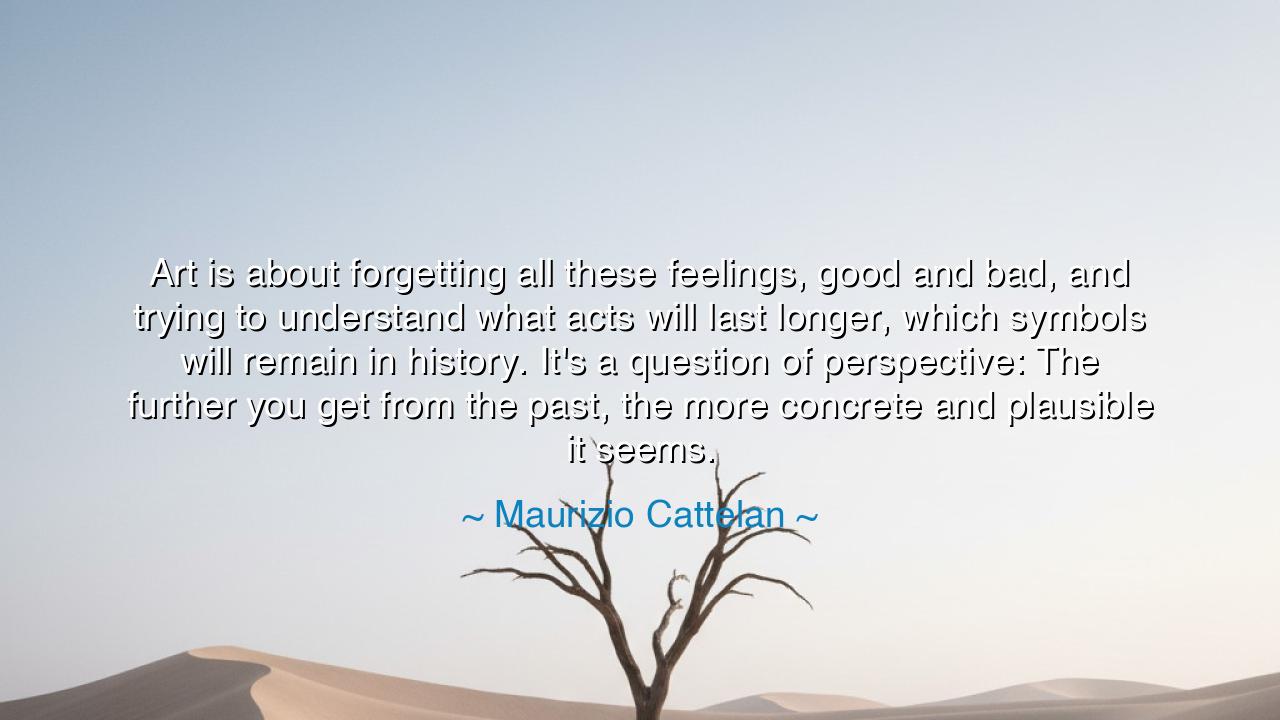
Art is about forgetting all these feelings, good and bad, and
Art is about forgetting all these feelings, good and bad, and trying to understand what acts will last longer, which symbols will remain in history. It's a question of perspective: The further you get from the past, the more concrete and plausible it seems.






“Art is about forgetting all these feelings, good and bad, and trying to understand what acts will last longer, which symbols will remain in history. It's a question of perspective: The further you get from the past, the more concrete and plausible it seems.” Thus spoke Maurizio Cattelan, the trickster-sage of modern art, whose works—provocative, ironic, and profound—challenge not only the eye but the conscience. In this reflection, he reveals a truth known to the ancients: that art is not merely the mirror of emotion, but the architect of memory. It does not live in the fleeting tremor of the heart, but in the slow endurance of time.
To the uninitiated, Cattelan’s words may sound paradoxical. How can art, that very vessel of human feeling, demand the forgetting of feelings? Yet here lies the secret: the artist must rise above the storm of emotion, not because emotion is unworthy, but because it blinds the eye to the eternal. The passions of the moment, both joy and despair, are like waves upon the ocean—they dazzle, they crash, they vanish. But the artist, like the ancient sculptor, seeks the stone beneath, the form that endures beyond the tide. To create something that lasts, one must look beyond oneself.
Cattelan himself has lived this paradox. His art—whether a satirical pope struck by a meteor or a golden toilet gleaming in a museum—has never sought to comfort, but to provoke thought about symbol and permanence. Behind his irony lies a deep reverence for history’s strange endurance. What survives the centuries, he reminds us, is rarely the purest emotion or the loudest voice—it is the symbol, the image that transcends its time because it carries a truth that humanity cannot forget. The artist, therefore, must not chase approval or sentiment, but the essence that time will preserve.
The ancients understood this mystery well. When Phidias carved the gods upon the Parthenon, or Homer sang of Achilles’ rage, they were not recording their own feelings—they were building monuments to the human condition itself. The sculptor’s chisel and the poet’s word became bridges between the mortal and the eternal. They did not ask what pleased their age; they asked what would remain when their age had turned to dust. In this way, they achieved what Cattelan describes: they created symbols so powerful that even millennia could not erode their meaning.
Yet there is wisdom, too, in Cattelan’s second truth: that the past grows more concrete with distance. What once seemed uncertain, chaotic, or absurd becomes clear only through the lens of time. The ancients believed that history was a river whose current could not be understood while standing within it. Only when one stands upon the far shore can one see its course. So it is with art. The artist may not know, in their own lifetime, what meaning their work will bear. It is only as generations pass—when emotion fades and perspective ripens—that the enduring truth reveals itself.
This is why the artist must work not for praise, nor for fame, but for legacy. Every age is blinded by its own passions, yet art endures by reaching beyond them. Van Gogh died in despair, believing himself forgotten; yet his sunflowers became the very symbol of resilience and beauty reborn from suffering. Michelangelo, battered by faith and fear, carved David not to celebrate his own feeling, but to embody courage itself. Both men, like Cattelan, understood that the artist’s task is not to capture emotion, but to transform it into symbol, so that those who come after may see in it their own reflection.
So let this be the lesson: create for the ages, not the hour. Whether your art is in words, deeds, or daily labor, do not be ruled by fleeting emotion. Feel deeply, yes—but then rise above feeling to see what truth will endure. Ask yourself not what pleases now, but what will still speak when the noise of the present has fallen silent. The ancients built temples; the moderns build ideas. Yet the calling is the same: to craft something that time itself must honor.
For as Maurizio Cattelan teaches, art—and by extension, life—is not about holding onto what is felt, but discovering what will last. When you look upon your work, ask: Will this be remembered? Will it still speak when I am gone? For in that question lies the path to immortality. And when centuries pass, and the dust of our era settles, it will not be the emotions of today that endure—but the symbols, the acts, the creations that reached beyond feeling to touch the eternal.






AAdministratorAdministrator
Welcome, honored guests. Please leave a comment, we will respond soon